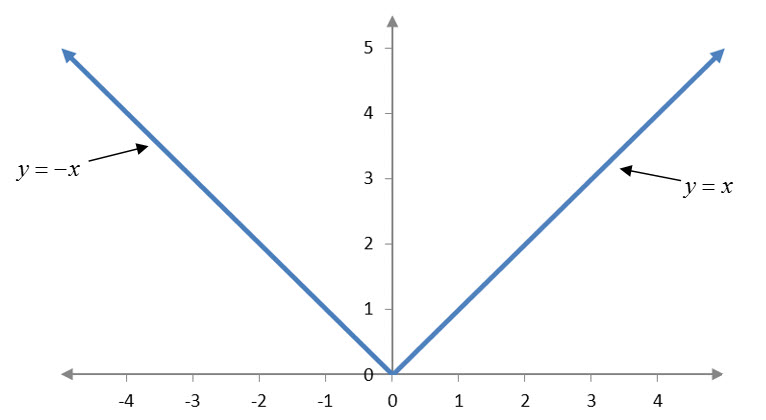What is a piecewise defined function?
The linear and quadratic functions we have introduced so far use a single rule to define the function. For a piecewise defined function, the function is defined by several rules. Each rule corresponds to a different piece of the function.
You are probably already familiar with one piecewise defined function. The absolute value function,
f (x) = |x|
appears to be a function that is defined by a single rule. However, if we look at the graph of the absolute value function, you see two different lines in the shape of a “v”.
Figure 4 – The absolute value function.
There are two pieces to the function. On the left side of x = 0, the function has a slope of -1 and a y-intercept of 0. On the right side of x = 0, the function has a slope of 1 and a y-intercept of 0. We can put this description together in a piecewise function as
Each line of the formula corresponds to a corresponding piece of the graph. To find an output from a piecewise function, we must determine which piece of the function the input belongs. For instance, the input x = -2 is in the top part of the function’s formula since this x value is less than zero. The output is
|-2| = -(-2) = 2
For a nonnegative input like x = 3, we find the output from the bottom part of the function’s formula,
|3| = 3
A piecewise function may have any number of pieces and may or may not be defined for every possible input. If there is no piece of the function defined for an input, we simply say the output is undefined.
Example 10 Piecewise Function
The Basic Plus Plan is a medical insurance plan offered by a self insured trust in Northern Arizona. The total annual cost (in dollars) to an insured person is
where x is the amount of medical charges incurred at the point of treatment.
a. Find the total annual cost for $5000 in medical charges.
Solution We must find the value of BP(5000). The input lies in the interval 1200 < x ≤ 27900 so the total annual cost is
BP(5000) = 0.4(5000) + 1392 = 3392
The total annual cost corresponding to $5000 in charges is $3392.
b. Find the total annual cost for $30,000 in medical charges.
Solution Medical charges of $30,000 lie in the third piece of the formula, so
BP(30000) = 12552
A person incurring $30,000 in medical charges would have a total annual cost of $12,552. In fact, for any amount of medical charges above $27,900. the total annual charge is $12,552. This is due to the fact that the plan has reached its out of pocket maximum at this level of charges.
c. Find the total annual cost for $250 in medical charges.
Solution No part of the function corresponds to so the output is undefined. The domain of the function is and this input lies outside of this interval.



